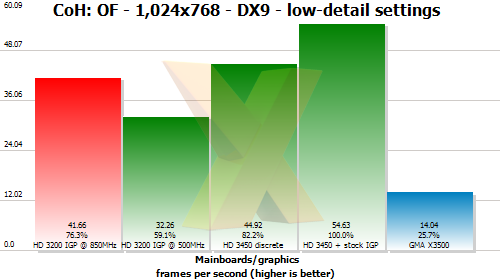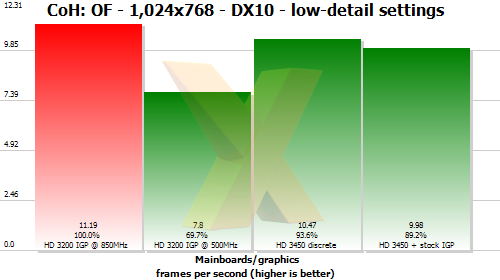Overclocking, power-draw, VC-1 decode
Overclocking the IGP
The Radeon HD 3200 GPU ships with a 500MHz engine speed and that's consistent amongst partners. However, it would have been remiss of us not to see just how high the 55nm-based IGP would go.With no additional cooling aimed at the passively-cooled northbridge, we hit 850MHz with ease, representing a 70 per cent increase over stock, and is higher than a discrete Radeon HD 3470's 800MHz engine clock.
We re-ran Company of Heroes (DX9 and DX10), to see how the extra speed was manifested in our benchmarks.

The 70 per cent engine increase translates to a 29 per cent improvement, and we suppose a lack of memory bandwidth is holding the IGP back. The extra performance isn't enough to beat out a 600/1,000MHz-clocked Radeon HD 3450 256MiB card.

Power-draw considerations
We tested power-draw by measuring the at-the-wall wattage. The systems were the same as detailed on page seven.The 2D load numbers represents Prime95 being run on all available cores. 3D load, however, attributes half the system memory and CPU power to Prime95 with the remainder tasked to run 3DMark06's Canyon test.
| Motherboards | Gigabyte 780G + Athlon X2 4850e | ASUS G35 + Intel Pentium Dual-Core E2180 |
|---|---|---|
| Power-draw, idle | 43W | 58W |
| Power-draw, load, 2D | 98W | 92W |
| Power-draw, load, 3D | 101W | 98W |
AMD makes a point of evangelising idle power-consumption, which is around 15W lower than the Intel setup. Is it important? The answer is probably yes; most people use their PCs for mundane tasks such as emailing and word-processing.
The under-load figures are far more similar, though.
HD VC-1 video-decode musings
Using system setups that were practically identical to those described on page seven, albeit with an Hitachi SD-H802A HD DVD-ROM drive, we replayed, via HDMI and at 1,920x1,080, chapter six of the VC1-encoded Harry Potter and the Goblet of Fire HD DVD via PowerDVD Ultra 7.3.3501.The average CPU utlilisation percentages are shown below.
| Motherboards | Gigabyte 780G + Athlon X2 4850e | ASUS G35 + Intel Pentium Dual-Core E2180 |
|---|---|---|
| Average CPU util. over three runs | 24.33 | 58.15 |
| Smooth playback | Yes | Yes |
| Picture quality via HDMI | Average | Average |
The second-generation UVD present in the 780G northbridge offloads much of the decoding work that results in an acceptably low CPU utilisation.
Intel's G35 chipset carries hardware-accelerated support for VC-1 decoding, too, but it doesn't seem particularly effective, causing a near-60 per cent CPU utilisation on a processor that's at least as capable, if not more so, than AMD's Athlon X2 4850e.
Lower CPU utilisation is always better, of course, but we note that both systems exhibited smooth, if somewhat fuzzy, playback via HDMI to a 24in ViewSonic monitor.









